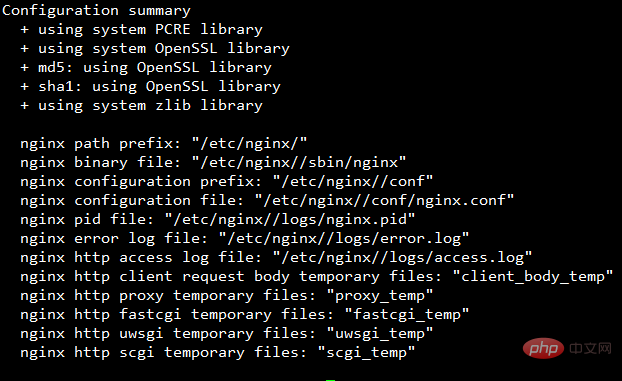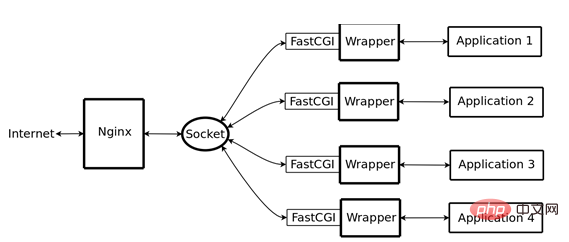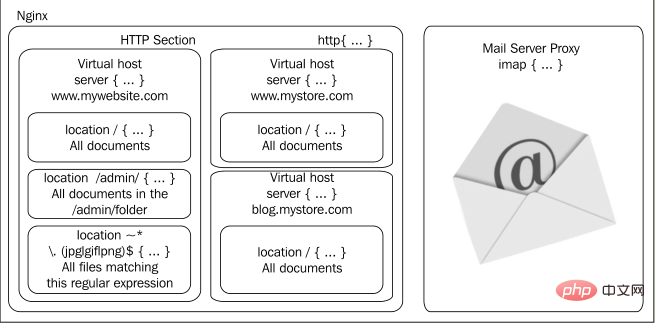 Betrieb und Instandhaltung
Betrieb und Instandhaltung
 Nginx
Nginx
 So konfigurieren Sie den Nginx-Server für das PHP-Programm unter dem Debian-System
So konfigurieren Sie den Nginx-Server für das PHP-Programm unter dem Debian-System
So konfigurieren Sie den Nginx-Server für das PHP-Programm unter dem Debian-System
Nginx-Installationsmethode:
1 apt-Netzwerkinstallation
Quellliste ändern
vi /etc/apt/sources.list #加入以下源 deb http://nginx.org/packages/debian/ squeeze nginx deb-src http://nginx.org/packages/debian/ squeeze nginx
Quelle aktualisieren Listen Sie Nginx über apt auf und installieren Sie es Daher müssen wir relevante Bibliotheksdateien im Voraus installieren.
apt-key add nginx_signing.key apt-get update apt-get install nginx
Laden Sie die neueste stabile Version von nginx herunter
Entpacken und Sehen Sie sich die Kompilierung an. Option
apt-get install build-essential apt-get install libpcre3 libpcre3-dev zlib1g zlib1g-dev openssl libssl-dev libssl0.9.8
Sehen Sie sich die optionalen Konfigurationsparameter für die Kompilierung an (im Folgenden sind nur einige allgemeine Konfigurationselemente aufgeführt):
--prefix=path Der Standardwert Installationspfad von Nginx, falls nicht angegeben. Der Standardwert ist /usr/local/nginx
--sbin-path=path Der Pfad zur ausführbaren Nginx-Befehlsdatei ist der Standardwert
结果如下图:

编译并安装
make && make install
ps:fastcgi回顾
fastcgi是一个可伸缩地、高速地在http server和动态脚本语言间通信的接口。多数流行的http server都支持fastcgi,包括apache、nginx和lighttpd等,同时,fastcgi也被许多脚本语言所支持,其中就有php。fastcgi是从cgi发展改进而来的。传统cgi接口方式的主要缺点是性能很差,因为每次http服务器遇到动态程序时都需要重新启动脚本解析器来执行解析,然后结果被返回给http服务器。这在处理高并发访问时,几乎是不可用的。另外传统的cgi接口方式安全性也很差,现在已经很少被使用了。fastcgi接口方式采用c/s结构,可以将http服务器和脚本解析服务器分开,同时在脚本解析服务器上启动一个或者多个脚本解析守护进程。当http服务器每次遇到动态程序时,可以将其直接交付给fastcgi进程来执行,然后将得到的结果返回给浏览器。这种方式可以让http服务器专一地处理静态请求或者将动态脚本服务器的结果返回给客户端,这在很大程度上提高了整个应用系统的性能。
nginx不支持对外部程序的直接解析,所有的外部程序(包括php)必须通过fastcgi接口来调用。fastcgi接口在linux下是socket,(这个socket可以是文件socket,也可以是ip socket)。为了调用cgi程序,还需要一个fastcgi的wrapper(wrapper可以理解为用于启动另一个程序的程序),这个wrapper绑定在某个固定socket上,如端口或者文件socket。当nginx将cgi请求发送给这个socket的时候,通过fastcgi接口,wrapper接纳到请求,然后派生出一个新的线程,这个线程调用解释器或者外部程序处理脚本并读取返回数据;接着,wrapper再将返回的数据通过fastcgi接口,沿着固定的socket传递给nginx;最后,nginx将返回的数据发送给客户端,这就是nginx+fastcgi的整个运作过程。

php-fpm
php5.3版本源码已经默认支持php-fpm了,但是debian6认为它还没经过广泛的测试,所以在debian6的软件仓库中,虽然php版本为5.3.3,但是却没包含php-fpm,如果不想手工编译安装php的话可以换一个源。
修改源列表
vi /etc/apt/sources.list deb http://packages.dotdeb.org stable all deb-src http://packages.dotdeb.org stable all
更新源列表,安装php5-fpm
apt-get update wget http://www.dotdeb.org/dotdeb.gpg cat dotdeb.gpg | apt-key add - apt-get install php5-fpm
安装其他常用php5组件
apt-get install php5 php5-cgi php5-cli php5-mysql php5-memcache
启动php-fpm
/etc/init.d/php5-fpm start
这样的话最基本的nginx+php环境就搭建完毕了。
nginx配置文件粗解
nginx的配置文件结构类似下图这样的结构:

配置文件主要参照编译完成后生成的默认配置文件。
主模块的配置选项
user指令设置进程以什么用户运行,在源码编译安装时指定的nginx用户,如果在编译时没有指定,默认是nobody账户,在配置文件中此行处于注释状态, user 指令可以设置两个参数,第一个指定进程所属用户,第二个是可选,指定进程所属组
user nginx nobody;
设置工作进程数,一个工作进程为一个单线程,在cpu密集型环境中,可以设置worker_processes数目为cpu核数
worker_processes 4;
指定nginx错误日志文件的位置,如果要禁止错误日志使用error_log /dev/null,error_log可以存在于不同的字段main、http、server等,文件后面可以指定记录的日志的默认等级。
error_log logs/error.log;
设置pid文件路径,可以使用kill命令发送相关信号
pid logs/nginx.pid;
event模块配置选项,event模块主要控制nginx处理连接的方式
events {
#如果在configure时指定的不止一个事件模型,可以通过use告诉nginx要使用哪一个模型:seletc、poll、kqueue、epoll、rtsig、/dev/poll、eventport等
use epoll;
#worker_connections和worker_processes可以计算你的理论最大链接数, worker_connections*worker_processes
worker_connections 1024;
}http模块里面主要是对http服务器相关属性进行设置
http {
#可以用include指令包含一些其他文件,支持通配符,可以使用绝对路径,也可以使用相对路径,相对路径以nginx.conf为根据
include mime.types;
#设置默认的mime类型
default_type application/octet-stream;
#描述记录日志的格式,在定义格式时可以使用一些变量,各个变了的含义可以从各个模块汇总查找
log_format main '$remote_addr - $remote_user [$time_local] "$request" '
'$status $body_bytes_sent "$http_referer" '
'"$http_user_agent" "$http_x_forwarded_for"';
#指定访问日志的路径和格式,缓冲区大小
access_log logs/access.log main;
#sendfile拷贝文件在内核态完成,更加高效
sendfile on;
#tcp_nopush on;
#可以设置两个值,第一个表示客户端与服务器长连接的超时时间,超过这个时间,服务器将关闭连接。第二个值指定的应答头中keep-alive中timeout的值,让浏览器知道什么时候关闭连接。
keepalive_timeout 65;
#开启gzip压缩
gzip on;
#在三次握手时,发送给客户端应答后的超时时间,目前还没进入连接状态,只完成了两次握手,如果在规定时间没收到应答包,nginx将关闭链接
send_timeout 30
server {
xxx
}
}server模块嵌在http模块中,主要用来配置虚拟主机
server {
#指定server字段中可以被访问到的ip地址及端口
listen 80;
#将http请求的主机头与server中的server_name参数进行匹配,并找出第一个结果,如果没有server_name参数匹配上,则第一个出现listen的server将被匹配,多域名用空格分割
server_name www.nginx.com;
#设个指令是应答头重的content-type字段使用指定的编码集,off表示不在应答头重添加content-type信息
charset off;
#指定www.nginx.com域名的访问日志路径及格式
access_log logs/host.access.log main;
#如果在url中没有指定文件,则设置一个默认主页,可以设置多个文件,空格分开,可以在http、server、location中设置
index index.php index.htm;
#根据url的不同需求进行配置,可以使用字符串和正则匹配,最确切的匹配被使用,搜索到第一个后会停止
# ~* 不区分大小写;~ 区分大小写;^~ 禁止在字符串匹配后检查正则;= 在url和location之间精确匹配,匹配完成后不做额外搜索。
location /i/ {
#请求到达后的文件根目录,在请求中root会把location匹配的值加到root指定的值后面,请求/i/a.php,则会是/html/i/a.php响应
root html;
#在location中设置index
index index.html index.htm;
}
#为错误代码指定相应的错误界面,可以用在http、server、location字段中。
error_page 404 /404.html;
# redirect server error pages to the static page /50x.html
error_page 500 502 503 504 /50x.html;
#精确匹配50x.html,真实响应是/html/50x.html
location = /50x.html {
root html;
}
# proxy the php scripts to apache listening on 127.0.0.1:80
location ~ \.php$ {
proxy_pass http://127.0.0.1;
}
#配置php脚本传至fastcgi
location ~ \.php$ {
root html;
fastcgi_pass 127.0.0.1:9000;
fastcgi_index index.php;
#/scripts是php脚本所在的目录
fastcgi_param script_filename /scripts$fastcgi_script_name;
include fastcgi_params;
}
#拒绝访问.htaccess文件
location ~ /\.ht {
deny all;
}
}Das obige ist der detaillierte Inhalt vonSo konfigurieren Sie den Nginx-Server für das PHP-Programm unter dem Debian-System. Für weitere Informationen folgen Sie bitte anderen verwandten Artikeln auf der PHP chinesischen Website!

Heiße KI -Werkzeuge

Undresser.AI Undress
KI-gestützte App zum Erstellen realistischer Aktfotos

AI Clothes Remover
Online-KI-Tool zum Entfernen von Kleidung aus Fotos.

Undress AI Tool
Ausziehbilder kostenlos

Clothoff.io
KI-Kleiderentferner

Video Face Swap
Tauschen Sie Gesichter in jedem Video mühelos mit unserem völlig kostenlosen KI-Gesichtstausch-Tool aus!

Heißer Artikel

Heiße Werkzeuge

Notepad++7.3.1
Einfach zu bedienender und kostenloser Code-Editor

SublimeText3 chinesische Version
Chinesische Version, sehr einfach zu bedienen

Senden Sie Studio 13.0.1
Leistungsstarke integrierte PHP-Entwicklungsumgebung

Dreamweaver CS6
Visuelle Webentwicklungstools

SublimeText3 Mac-Version
Codebearbeitungssoftware auf Gottesniveau (SublimeText3)

Heiße Themen
 Zweck von PHP: Erstellen dynamischer Websites
Apr 15, 2025 am 12:18 AM
Zweck von PHP: Erstellen dynamischer Websites
Apr 15, 2025 am 12:18 AM
PHP wird verwendet, um dynamische Websites zu erstellen. Zu den Kernfunktionen gehören: 1. Dynamische Inhalte generieren und Webseiten in Echtzeit generieren, indem Sie eine Verbindung mit der Datenbank herstellen; 2. Verarbeiten Sie Benutzerinteraktions- und Formulareinreichungen, überprüfen Sie Eingaben und reagieren Sie auf Operationen. 3. Verwalten Sie Sitzungen und Benutzerauthentifizierung, um eine personalisierte Erfahrung zu bieten. 4. Optimieren Sie die Leistung und befolgen Sie die Best Practices, um die Effizienz und Sicherheit der Website zu verbessern.
 PHP und Python: Code Beispiele und Vergleich
Apr 15, 2025 am 12:07 AM
PHP und Python: Code Beispiele und Vergleich
Apr 15, 2025 am 12:07 AM
PHP und Python haben ihre eigenen Vor- und Nachteile, und die Wahl hängt von den Projektbedürfnissen und persönlichen Vorlieben ab. 1.PHP eignet sich für eine schnelle Entwicklung und Wartung großer Webanwendungen. 2. Python dominiert das Gebiet der Datenwissenschaft und des maschinellen Lernens.
 PHP und Python: Verschiedene Paradigmen erklärt
Apr 18, 2025 am 12:26 AM
PHP und Python: Verschiedene Paradigmen erklärt
Apr 18, 2025 am 12:26 AM
PHP ist hauptsächlich prozedurale Programmierung, unterstützt aber auch die objektorientierte Programmierung (OOP). Python unterstützt eine Vielzahl von Paradigmen, einschließlich OOP, funktionaler und prozeduraler Programmierung. PHP ist für die Webentwicklung geeignet, und Python eignet sich für eine Vielzahl von Anwendungen wie Datenanalyse und maschinelles Lernen.
 PHP: Datenbanken und serverseitige Logik bearbeiten
Apr 15, 2025 am 12:15 AM
PHP: Datenbanken und serverseitige Logik bearbeiten
Apr 15, 2025 am 12:15 AM
PHP verwendet MySQLI- und PDO-Erweiterungen, um in Datenbankvorgängen und serverseitiger Logikverarbeitung zu interagieren und die serverseitige Logik durch Funktionen wie Sitzungsverwaltung zu verarbeiten. 1) Verwenden Sie MySQLI oder PDO, um eine Verbindung zur Datenbank herzustellen und SQL -Abfragen auszuführen. 2) Behandeln Sie HTTP -Anforderungen und Benutzerstatus über Sitzungsverwaltung und andere Funktionen. 3) Verwenden Sie Transaktionen, um die Atomizität von Datenbankvorgängen sicherzustellen. 4) Verhindern Sie die SQL -Injektion, verwenden Sie Ausnahmebehandlung und Schließen von Verbindungen zum Debuggen. 5) Optimieren Sie die Leistung durch Indexierung und Cache, schreiben Sie hochlesbarer Code und führen Sie die Fehlerbehandlung durch.
 So konfigurieren Sie den Namen des Cloud -Server -Domänennamens in Nginx
Apr 14, 2025 pm 12:18 PM
So konfigurieren Sie den Namen des Cloud -Server -Domänennamens in Nginx
Apr 14, 2025 pm 12:18 PM
So konfigurieren Sie einen Nginx -Domänennamen auf einem Cloud -Server: Erstellen Sie einen Datensatz, der auf die öffentliche IP -Adresse des Cloud -Servers zeigt. Fügen Sie virtuelle Hostblöcke in die NGINX -Konfigurationsdatei hinzu, wobei der Hörport, Domänenname und das Root -Verzeichnis der Website angegeben werden. Starten Sie Nginx neu, um die Änderungen anzuwenden. Greifen Sie auf die Konfiguration des Domänennamens zu. Weitere Hinweise: Installieren Sie das SSL -Zertifikat, um HTTPS zu aktivieren, sicherzustellen, dass die Firewall den Verkehr von Port 80 ermöglicht, und warten Sie, bis die DNS -Auflösung wirksam wird.
 So überprüfen Sie den Namen des Docker -Containers
Apr 15, 2025 pm 12:21 PM
So überprüfen Sie den Namen des Docker -Containers
Apr 15, 2025 pm 12:21 PM
Sie können den Namen des Docker -Containers abfragen, indem Sie den Schritten folgen: Alle Container auflisten (Docker PS). Filtern Sie die Containerliste (unter Verwendung des GREP -Befehls). Ruft den Containernamen ab (befindet sich in der Spalte "Namen").
 So überprüfen Sie, ob Nginx gestartet wird
Apr 14, 2025 pm 01:03 PM
So überprüfen Sie, ob Nginx gestartet wird
Apr 14, 2025 pm 01:03 PM
So bestätigen Sie, ob Nginx gestartet wird: 1. Verwenden Sie die Befehlszeile: SystemCTL Status Nginx (Linux/Unix), Netstat -ano | FindStr 80 (Windows); 2. Überprüfen Sie, ob Port 80 geöffnet ist; 3. Überprüfen Sie die Nginx -Startmeldung im Systemprotokoll. 4. Verwenden Sie Tools von Drittanbietern wie Nagios, Zabbix und Icinga.
 PHP vs. Python: Anwendungsfälle und Anwendungen
Apr 17, 2025 am 12:23 AM
PHP vs. Python: Anwendungsfälle und Anwendungen
Apr 17, 2025 am 12:23 AM
PHP eignet sich für Webentwicklungs- und Content -Management -Systeme, und Python eignet sich für Datenwissenschafts-, maschinelles Lernen- und Automatisierungsskripte. 1.PHP hat eine gute Leistung beim Erstellen von schnellen und skalierbaren Websites und Anwendungen und wird üblicherweise in CMS wie WordPress verwendet. 2. Python hat sich in den Bereichen Datenwissenschaft und maschinelles Lernen mit reichen Bibliotheken wie Numpy und TensorFlow übertrifft.





